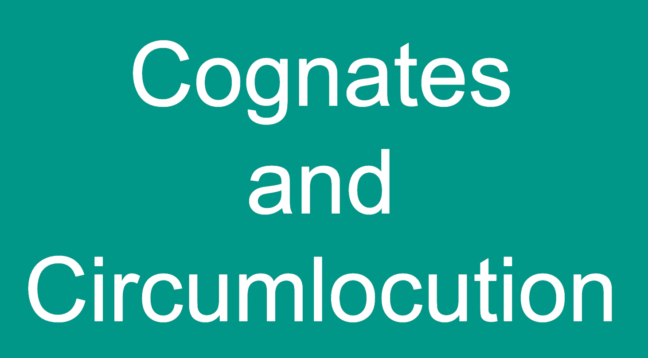By Vicky Masson
‘Why do we teach…?‘ is a column of Language Teaching Lab. It might help us think deeper on why we teach a certain topic. In addition, it might show a new perspective on how to teach it.
Learning about ‘cognates’ and ‘circumlocution’ helped students feel successful during an assessment. When my students finish their assessments most of the time I ask for feedback. I want to know what my students are thinking and feeling. After the last presentational writing, I asked my students what helped them while they were writing.
In a group of ten students, two said that they thought of cognates to help them write or figure out words to use in their writing. A third student told me that he thought of the game we play where “you say words about something without mentioning the word”. He said that it helped him come up with words to use in his writing.

Why I teach the word ‘cognate’ the first day of class
Many years ago, as summer reading, my students read Cuba 15 by Nancy Osa. As far as I remember, very early in the novel, we learn about the power of ‘cognates.’ That was one of the first words the Spanish teacher taught her class. I teach my students the word ‘cognate’ the very first day we meet as a class.
Learning about cognates makes a huge difference in the quantity of vocabulary a novice proficiency level language student might acquire. I invite students to act like detectives, trying to find clues in words by comparing them to their native language.
How I use ‘cognates‘
Once students feel comfortable being language ‘detectives,’ I purposefully ask them to find cognates in interpretive reading taks and listen for cognates in interpretive listening tasks first of all.
Students immediately realize that by looking for cognates, they already understand many words in the text or audio, even before starting to analyze it.
While having class discussions or group conversations they tend to ask ‘how do you say…?’ I immediately tell them that the word is a cognate and ask them if they can figure out what it can be, which they do 90% of the time. Some of my students even create their own list of cognates and refer to it during practice assessments or assignments.
Where I find resources
Co-creating a list of cognates or presenting students with lists of cognates are ways of increasing the variety of vocabulary they can use. My go to lists are Colorin Colorado and Mondly.
Why I teach ‘circumlocution‘
Teaching circumlocution increases communication in world language classes. I learned about circumlocution during an OWL (Organic World Language) professional development training many years ago. According to dictionary.com, circumlocution is “a roundabout or indirect way of speaking; the use of more words than necessary to express an idea.” In general, we are taught to use the best words to express our thoughts so it seems that circumlocution is contradictory. When it comes to languages, it is not.
Why do I think that teaching ‘circumlocution’ is one of the best gifts I can give my students? Simply put, it helps students stay in the language using words that they know and figuring out how to express their thoughts with the content they own.
How I teach ‘circumlocution‘
Circumlocution expands students’ vocabulary and at the same time, It helps learners categorize. Categories help students be able to express themselves in the language they are learning by making associations among words that share the same or similar carachteristics. Learning circumlocution is a game changer!
I usually use games to help students use circumlocution, like the one my student mentioned after the assesment. I call that ‘Adivina’ which basically means ‘guess.’ It is a low prep game where you show a picture to students. One of them describes one of the objects in the picture and the others (usually in groups) have to guess what it refers to. The one who guesses chooses the next word. A similar game is the famous ‘20 questions’ in which students have 20 questions to find out the chosen word. Both games are favorites in my classes.
What are some structures to use
A simple search in Quizlet or Kahoot will give you ready-to-use activities to practice circumlocution. If you search Teachers Pay Teachers or Pinterest you will also find lots of useful resources.
‘Cognates’ and ‘circumlocution‘
My premise is that I teach a language with the purpose of having my students think and communicate (locally or globally) what they want to say and how, in another language. When I provide tools like cognates and circumlocution, students take ownership of their learning and feel successful in class. I want students to stay in the language and also to take risks, so cognates and circumlocution give students superpowers.
Resources mentioned
–Cuba 15 by Nancy Osa – As an Amazon Associate LTL earns from qualifying purchases
